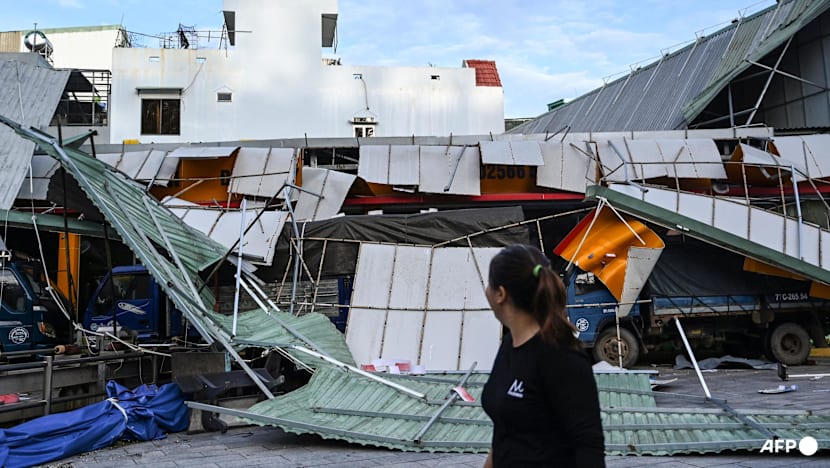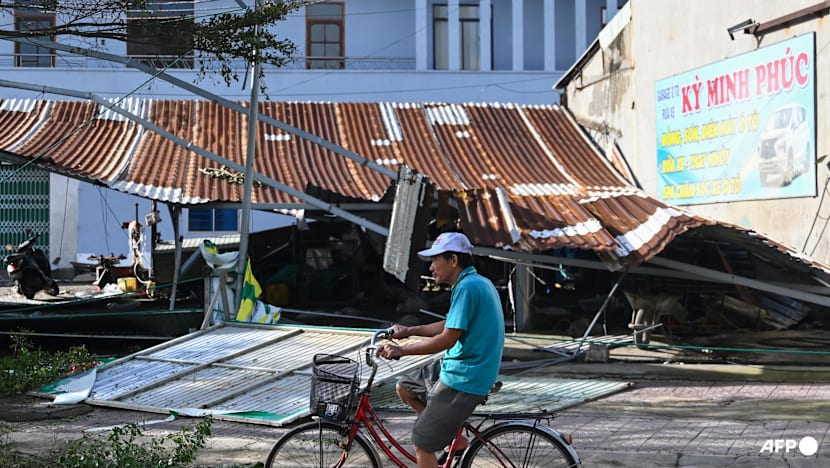Typhoon Kalmaegi hammers central Vietnam, killing at least 5
Areas in central Vietnam reported damaged buildings, electricity poles and fallen trees as Kalmaegi weakened to a tropical storm and moved into Cambodia.

A woman looks at a damaged structure with a partially collpased roof in Quy Nhon in Gia Lai province, central Vietnam, on Nov 7, 2025, after Typhoon Kalmaegi hit the area. (Photo: AFP/Nhac Nguyen)
NHA TRANG: At least five people died in Vietnam after Typhoon Kalmaegi pummelled coastal regions with destructive winds and heavy rain, officials said on Friday (Nov 7), following the storm's deadly passage through the Philippines where it killed at least 188 people.
Areas in central Vietnam reported damaged buildings, electricity poles and fallen trees as Kalmaegi weakened to a tropical storm and moved into Cambodia.
The disaster management agency said seven people were reported injured, and around 2,800 homes were damaged. About 1.3 million people were without electricity, it said.
State-run Vietnam News Agency reported damage to railway infrastructure in Quang Ngai province.
In the Philippines, President Ferdinand Marcos Jr declared a state of national emergency on Thursday as another potentially powerful typhoon was expected to slam into the Philippines’ western coast Sunday night or Monday morning.
Kalmaegi left at least 188 people dead and 135 missing in the deadliest natural disaster to hit the country this year, the Office of Civil Defense said.


VIETNAM EVACUATES
Kalmaegi made landfall in central Vietnam late on Thursday, uprooting trees, damaging homes, and triggering power outages, before weakening as it moved inland.
Waves up to 3m high hit the coast in coastal cities like Danang, and strong winds uprooted trees in Dak Lak province. Many homes in Quy Nhon, also a coastal city, were left without power for hours
Three fishermen were reported missing on Thursday after their boat was swept away by strong waves on Ly Son, an island in Vietnam's Quang Ngai province.
A search operation was launched but later suspended due to worsening weather, state media said.
In Gia Lai province, which bore the brunt of the typhoon, shrimp farm owner Nguyen Dinh Sa reported catastrophic losses.
"I went to check them every hour yesterday until evening. I had done everything but could not save them," Sa, 26, said, lamenting the destruction of around six tonnes of shrimp.
"All my investments are gone. I am so desperate at the moment," he said. Sa's two-storey warehouse, used for storing shrimp feed, was briefly submerged due to 7m-high waves and strong winds, leading to an estimated loss of around 1 billion dong (US$38,000).
The state-run Vietnam News Agency said the railway in Quang Ngai had been damaged. Photos and videos on social media showed ripped-off roofs, flooded homes, and streets littered with fallen trees and debris.

Authorities said more than 537,000 people were evacuated, many by boat.
They warned of continuing heavy rainfall of up to 200mm in central provinces from Thanh Hoa to Quang Tri, and said rising river levels from Hue to Dak Lak could trigger flooding and landslides.
Vietnam's central provinces were already reeling from floods due to record-breaking rains.
The government said it had mobilised more than 268,000 soldiers for search-and-rescue operations and warned of flooding, which could affect agriculture in the Central Highlands, Vietnam's main coffee-growing region.
Kalmaegi is expected to move through Laos and hit northeast Thailand in the afternoon. Thailand's Meteorological Department advised people in the region to be cautious of heavy to very heavy rainfall that could lead to flash floods or river overflows.
PHILIPPINES BRACES FOR NEXT POWERFUL STORM
Meanwhile, the next approaching storm, Fung-wong, was growing as it barreled toward the Philippines over the Pacific. State forecasters said Fung-wong, known as Uwan in the Philippines, could grow to a massive estimated 1,400km in diameter before it makes landfall in northern Aurora province or nearby regions.
They warn that it could hit the densely populated area around the capital, Manila.
Typhoon Kalmaegi displaced more than 560,000 villagers in the Philippines, including nearly 450,000 who were evacuated to emergency shelters, the Office of Civil Defense said. More than 318,000 others are still in evacuation shelters.
Marcos visited evacuation centres on Friday, distributing relief aid and assuring victims of continued government support, after Kalmaegi left 135 people missing and injured 96 others.
"We are very, very sorry," he told provincial officials.
"Most of the victims were carried away by the rushing waters, the sheer volume and speed of the flash floods."
“We suffered many deaths ... it was very grave,” Marcos said on Thursday of Kalmaegi’s deadly aftermath, but he said: "The biggest problem that we’re seeing is, we have to think who and how many of the personnel now handling government relief and support in the central Visayas region can be shifted to prepare for Uwan."
In Cebu, rampaging floodwaters submerged or swept away scores of vehicles in scenes that were caught on camera by residents stranded on roofs.
One of the mourners was Krizza Espra, who went Thursday to a mortuary to see the bodies of her husband and three children, who were killed when the roof they were sheltering on collapsed.
She said four others in her family - including her mother and aunt - remain missing.
"I hope someone can help speed up the search for their bodies before (they) decompose, we hope we can still recognise them," she said.
Marcos’s “state of national calamity” declaration allows the government to disburse emergency funds faster and prevent food hoarding and overpricing.
STORM AFTER STORM
The Philippines experiences about 20 typhoons and storms each year. The country is also often hit by earthquakes and has more than a dozen active volcanoes, making it one of the world’s most disaster-prone countries.
Vietnam, which gets about a dozen typhoons and storms a year, has been pummeled by a relentless series this year, leaving little time to recover between disasters.
Typhoon Ragasa dumped torrential rain in late September, then Typhoon Bualoi slammed the central coast and Typhoon Matmo resulted in flooding in the north. Together, the three storms left more than 85 people dead or missing in two weeks, and caused an estimated US$1.36 billion in damage.
Vietnam is among the world’s most flood-prone countries, with nearly half its population living in high-risk areas. Scientists warn that a warming climate is intensifying storms and rainfall across Southeast Asia, making floods like this year’s increasingly destructive and frequent.














